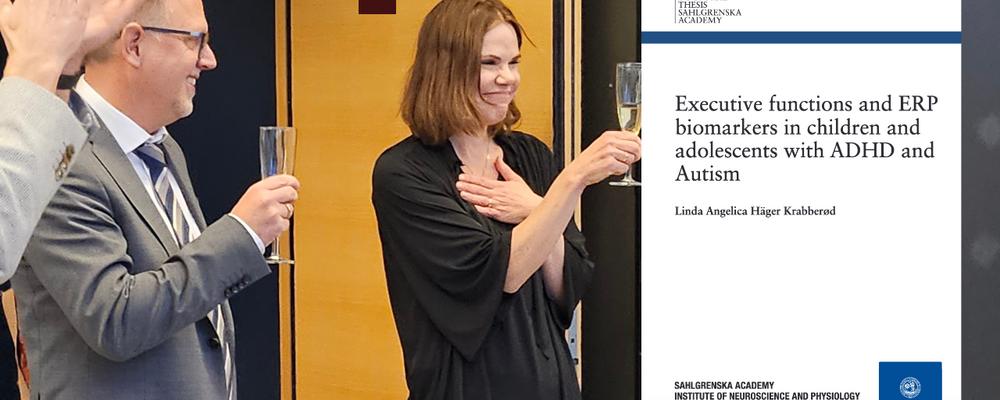
- Home
- News and events
- Find news
- Linda Häger successfully defends her thesis
Linda Häger successfully defends her thesis
GNCs Linda Häger successfully defends her thesis on "Executive functions and ERP biomarkers in children and adolescents with ADHD and Autism".

The GNC is thrilled to announce that Linda Häger successfully defended her thesis 17th November 2023. Linda, the most recent PhD student of the GNC, presented her research at the Arvid Carlsson Lecture Hall, located at Medicinaregatan 3. A short summary of her thesis entitled "Executive functions and ERP biomarkers in children and adolescents with ADHD and Autism" can be found below.
Background
Executive Functions (EF) refer to skills that help us initiate, organise and evaluate activities. Problems with EF are associated with neurodevelopmental disorders such as Attention-Deficit Hyperactivity Disorder (ADHD) and autism spectrum disorder (ASD). In the present project, we use parent ratings, scores from an attention test (a cued visual continuous performance test [VCPT]) and Event Related Potentials (ERPs) to examine EF.
Aim
The overarching aim of this thesis has been to learn more about the underlying neurocognitive bases of ADHD, ASD, EF, and to explore the possibilities of using ERPs and VCPT scores as supplementary diagnostic tools.
Study 1
In study 1, we studied correlations of different measures of EF in 59 ADHD patients. We found that the correlations between the EF measures were different among children (9-12 years) and adolescents (13-17 years), indicating developmental dynamics. The overall conclusion of the study was that the different measures of EF are complementary, each contributing unique knowledge.
Study 2
In study 2, the goal was to develop and evaluate a diagnostic ADHD index by combining data from ERP assessments and scores from the VCPT. Initially, sixty-one children with ADHD and 69 “typically developing children” (TDC) participated. The calculated index discriminated between the ADHD and the TDC groups with a large effect size (d=1.47). In a replication sample, d was 3.03.
Study 3
In study 3, we compared ERPs and test scores for 63 adolescents with ASD and 60 TDC. We found no significant group differences in behavioural test scores. However, several visual ERP components differed with largest difference seen in ERP component Visual Negativity (vN) which is assumed to reflect visual preparation. This finding is in accordance with theories claiming that predictive mechanisms are altered in ASD.
Study 4
Study 4 was a comprehensive case study of a boy with ADHD, mathematical disability and nonverbal
learning disability, illustrating how clinical information from several methods, including EPR-data, can be integrated.
Conclusion
In summary, it is argued that ERPs can contribute to diagnostic conclusions and increased understanding of EF problems related to ADHD and ASD.
Keywords
Supplementary biomarkers, child psychiatry, ADHD, autism, executive function, neuropsychological tests, event related potentials, EEG
Opponent and examining committee
Opponent: Associate Professor Matti Cervin, Department of Clinical Sciences, Lunds universitet, Lund, Sweden.
Examining committee: Asscoiate Professor Agneta Ekman (chair), Asscoiate Professor Pär Nyström (UU) and Professor Emeritus Erland Hjelmquist
